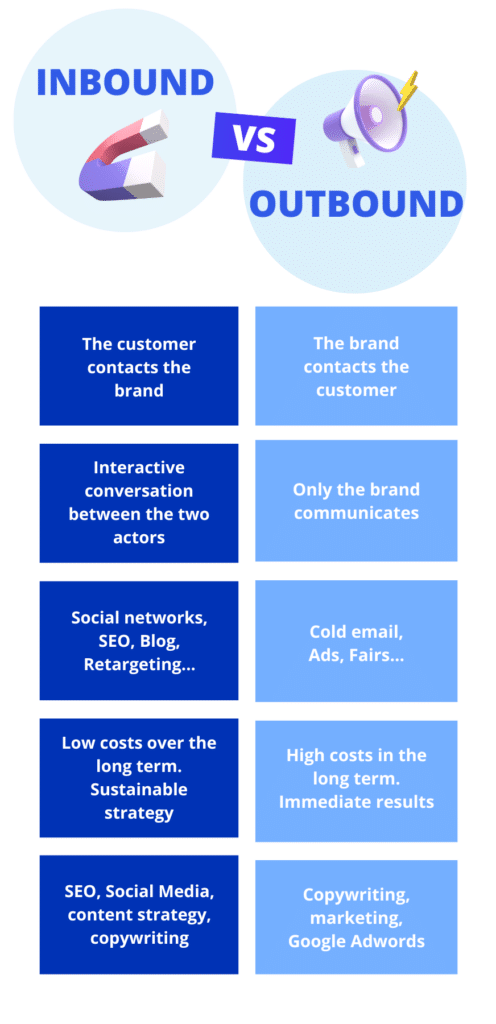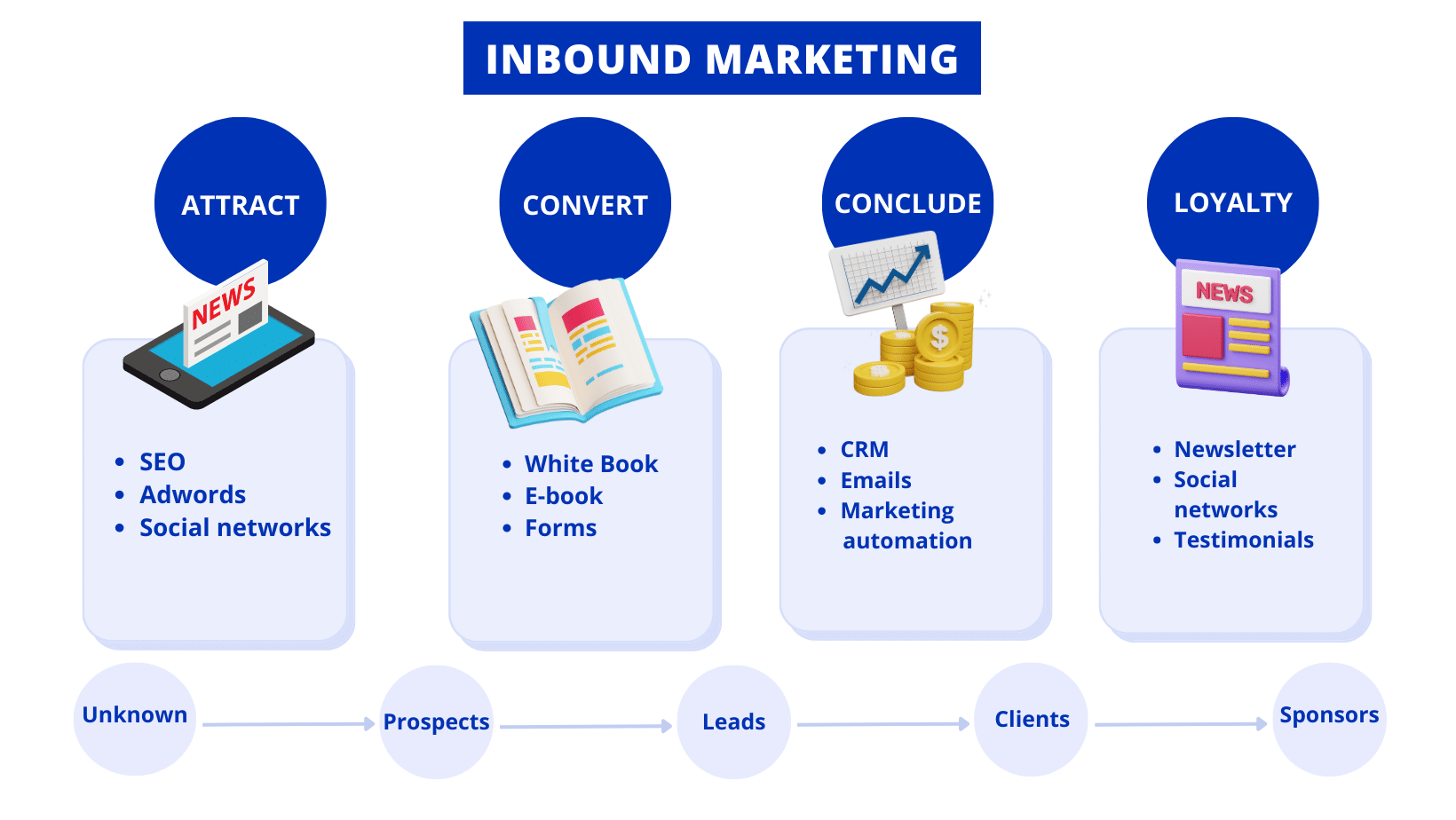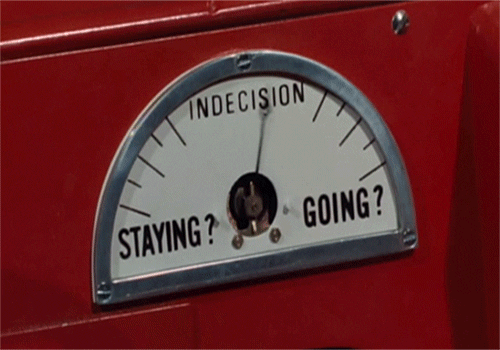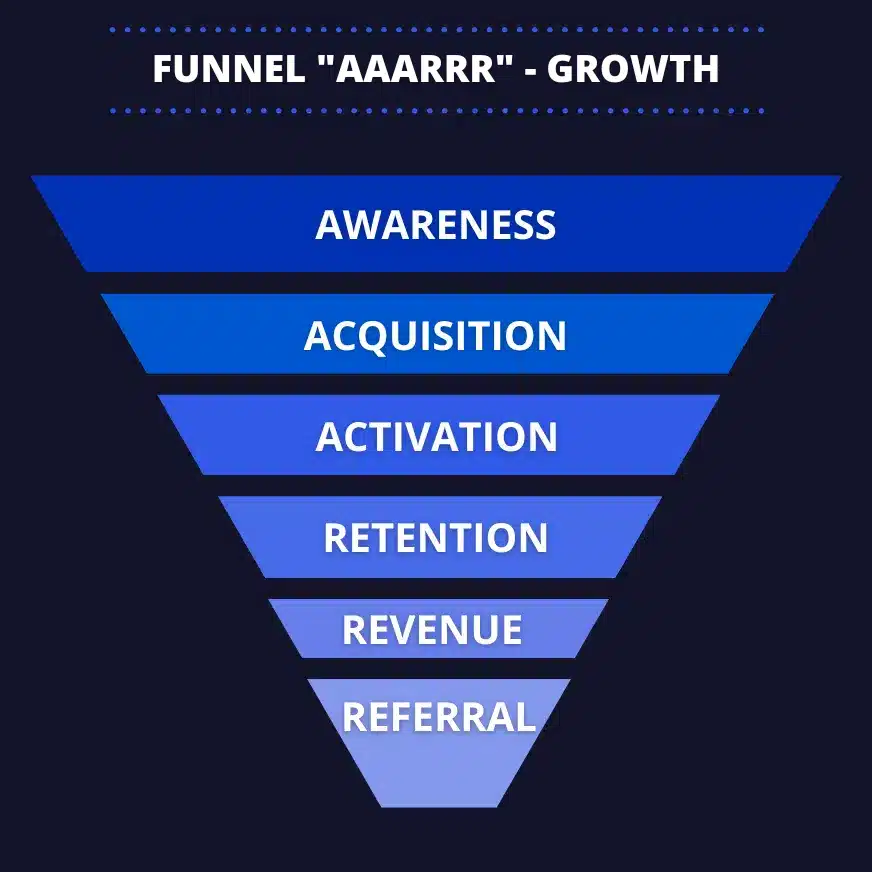As soon as you want to sell 💰 something, it’s always more convenient that the customer comes to you, that they know you. Do you know what we call this? Inbound marketing.
Today, I’m going to give you all the keys to understand Inbound marketing, to master it and for you to be unstoppable on the subject. Take notes ✒️, this is going to kick ass.
I have to warn you though, this guide is going to be very dense. That’s why it will be divided into several parts to make it easier to understand. During this program, we will see :
- The definition of inbound marketing.
- How to set up an inbound marketing methodology.
- How to prepare your inbound marketing strategy.
- The 4 steps of this strategy ✅.
- How to improve your content.
- Using marketing automation.
- Lead nurturing.
Inbound marketing definition
When you want to sell a product, there are several ways to do it. We can either go and get the customer, or we can make the customer come directly to us ❤️🔥. This second point is what we’ll focus on. Inbound marketing is a term we borrowed from the language of Shakespeare and it means “Inbound Marketing”. The goal is to make the customer come directly to you through your content ✒️. The good thing is that the customers coming to you will already be qualified and will already know your services 😀. To implement an Inbound Marketing strategy, you need to create a content strategy. This strategy will allow you to:
- Attracting customers to your website, your social networks, your blog.
- Getting your customers to come and ask you questions about a product or service that may interest them.
- Convert your leads into customers.
- Close your sales.
- Build customer loyalty.
So you will have understood, the objective 🏅 is to bring a prospect who does not know you, to become a customer through the creation of content. This term appeared in 2006 and comes from “Permission marketing” first initiated by Seth Godin.
They realized that by getting permission from targeted people, the conversion rate was much better. This is where Inbound Marketing comes from. And we’re going to implement it through the creation of various content.
The principles of inbound marketing
As we explained earlier in this article, inbound marketing is based on 4 important phases:
- Attracting. You need to get visitors to come to your site.
- Convert: It’s good that they come to your site, it’s better if they take an action. We can for example take the subscription to a newsletter for an action.
- Sell: They are completely interested in your product or service but they still have brakes. The lead nurturing will help your prospect to gain maturity in order to buy your services.
- Loyalty : The Holy Grail 🏆 is when your customers are satisfied with what you offer and therefore start talking about you to their friends and family. That’s exactly what we want.
During these 4 steps, you will produce content. But you still need to know where you are going to put them.
What is the difference between Outbound and Inbound Marketing with Examples?
“Outbound marketing”, as opposed to “inbound marketing”, is all about going after the customer. In general, it involves using prospecting and advertising as acquisition channels.
It is often opposed to an inbound strategy, as if a choice had to be made, whereas the two are complementary and much more powerful when they are well combined. We will have the opportunity to come back to this as well.
Among the outbound marketing strategies, we can mention :
- Door to door marketing,
- TV and social media advertising,
- Distribution of flyers, leaflets & samples,
- Sponsored links,
- Prospecting on LinkedIn or by email,
- Cold calling.
The outbound marketing will be useful to obtain customers quickly, on more or less important volumes.
These strategies are effective if you have large budgets but have the disadvantage of not “scaling up” easily, of being very costly and of being effective only at the beginning of the sales tunnel.
And above all, unlike inbound, this strategy has two disadvantages:
- There is no long tail: when you stop prospecting or stop advertising, the acquisition does not last.
- There is no scale effect and exponential results: if you want 10 times more customers, you have to pay 10 times more advertising or have 10 times more sales people to prospect.

Outbound marketing
“Outbound marketing”, as opposed to “inbound marketing”, aims to go and find the customer. In general, this means using prospecting and advertising as acquisition channels. It is often opposed to an inbound strategy, as if a choice had to be made, whereas the two are complementary and much more powerful when well combined.
👉 Outbound marketing will be useful to get customers quickly, on more or less important volumes. These strategies are effective if you have large budgets but have the disadvantage of not scaling up easily, of being very costly and of being effective only at the beginning of the sales tunnel. And above all, unlike inbound, this strategy has two disadvantages:
- There is no long tail: when you stop prospecting or stop advertising, the acquisition does not last.
- There is no scale effect and exponential results: if you want 10 times more customers, you have to pay 10 times more advertising or have 10 times more sales people to prospect.
The different types of content
To do Inbound Marketing, we can use:
- Social media 📱 (in order to create content).
- Set up webinars or lives.
- Create video content on YouTube.
- Podcasts.
- Natural referencing on search engines (Google, Bing or Yahoo).
So you’ve certainly understood, Inbound marketing will focus on a content creation strategy in which you will have to be diligent.

The 4 steps of the Inbound Marketing strategy
To understand an Inbound Marketing strategy, we will have to look at the 4 steps that make it up. ⏬
#1 Attract
Like the AAARRR framework, we will look at the 4 pillars of the Inbound Marketing strategy. We will talk about the conversion funnel and the first step of this conversion tunnel is to attract your customer or traffic to you, whether it is on your website or on your LinkedIn profile.
The goal is to turn a stranger into a visitor. You will attract them with marketing techniques so that they come and take a look at your services or products. Of course, in order for this to happen, you will need to know the problems of your potential customers 💰. To know these issues, there is only one solution: set up a persona.

You will certainly find it heavy because you only see it in our articles but it is the crucial step you must put in place if you want to sell. The persona is a fictional representation of your ideal customer. It is the person who is most likely to buy your products or services.
If you want to learn more about developing a marketing persona, this is 👉 where it happens. Once you have your ideal customer profile in place, you’re going to need to reach out to them. And we do that through the optimization of your web pages, your content by targeting the right keywords that come to answer the problems of your personas.
Above all, don’t forget to adapt the platform according to the preference of your audience.
#2 Convert
In this second phase, it’s about turning a visitor into a prospect. They can come on your website or on your LinkedIn profile, if nothing holds their attention, then you have failed. You’re going to have to spark that visitor’s interest and curiosity.
You’re going to have to set up calls to action (also known as CTAs) for your customers to sign up. But be careful, you have to offer them high value content, make a strong value proposition which could be a PDF, a white paper or even access to a webinar so that your leads will want to leave you data. Setting up content tailored to your leads as well as CTAs are called marketing levers.
#3 Sell
This is when you start to get interesting data about your targets. This is the phase where your prospect will become a customer (at least that’s what we want).
He may not be ready to go beyond the last barriers to make a purchase 💰 from you, that’s where lead nurturing comes in. Stay with us a little longer, we’ll talk about it a little later in this article. We recommend combining it with a marketing automation tool.
As I said, it is not because a prospect is interested and that he came on your site that he is ready to buy from you. In fact, according to Gleanster Research, more than 50% of qualified leads don’t think about closing the deal at all. This is why we talk about lead nurturing.
You will have to help your prospect gain maturity by offering them content adapted to their needs according to their stage of maturation in your sales funnel.
Once you’ve successfully moved your prospect to the buying act, the journey isn’t over yet 💡. The goal is for them to promote your brand.
#4 Build loyalty
We finally get to the stage where your customer will become an ambassador 💣. He has bought your product or service and the question remains whether he is satisfied with what you have presented him. To do this, you can send questionnaires and offer them content (always with added value) or promotional offers.
It is always good to keep loyal customers since, retaining ❤️ its customers costs much less than acquiring new ones. Therefore, it is important not to neglect them since they will be likely to recommend you to other people. To keep them, you will therefore have a strategy adapted for this particular audience.
Communicate with customers who are already with you. You show them that you are interested in them after a purchase and that you want to improve your services with new features. You will show them that you are listening to their needs continuously.
How to prepare your inbound marketing strategy?
Now that we’ve seen how to set up an Inbound marketing strategy, we’re going to look at the strategy that needs to be put in place, how to prepare it and how to set up.
The AAARRR framework
In marketing, especially for content creation, we can also use a framework that has proven itself. We are talking about the famous AAARRR. It is the basic framework of growth marketing that allows to present the sales funnel for a user but it applies perfectly to content. In this framework, we will find different terms such as :
- Awareness: The prospect has heard something about you or your products and starts to be interested.
- Acquisition: The prospect makes a first step towards you or a first step towards the sale. This is usually done by visiting your website or signing up for a newsletter.
- Activation: The prospect, now a user, takes a first action that will allow him to see the value of your product or service.
- Retention: The prospect comes back regularly. They get in touch again, revisit our site or use our product regularly in a free version. Sometimes we define retention as a user who continues to pay for the service.
- Revenue: The prospect becomes a customer and pays for our services.
- Referral: The customer now talks about our products around him, even outside a commercial relationship. He recommends our product, contributing to its success. This is THE best way to acquire new customers 🚨.
Content is perfectly integrated in the whole marketing funnel.
Content is a product
As we told you, the AAARRR framework applies very well to content creation since you will :
- Attract attention: work on the title, the hook of the LinkedIn post, your profile picture, the interface of your blog.
- Generate an action: a content must propose a specific action to maintain the relationship. Comment on the post, join a community, subscribe to a newsletter, read another article.
- Build loyalty: content must be qualitative to build loyalty. It must bring value. A content that attracts attention but does not satisfy in the end and does not make the audience come back is not successful. The content must create a long term relationship.
- Encourage sharing: this is the consequence of quality content. We want to share it, to talk about it around us, to create a “virality loop”.
- Be part of an income strategy: at some point, the content must have an objective of generating income. In other words, you should also make content with the goal of getting known and converting. 🌠
How to set up an Inbound Marketing methodology?
As I told you earlier in this article, you will have to be diligent. Content strategy takes time 🕰 and continuous investment. The results can be hard to measure accurately and can be a long time coming, but the payoff is truly worth it.
To implement an Inbound marketing strategy, you’re going to need to focus on a few things.
#1 Assert yourself as an expert to your target
This is one of the most important points of this topic. In order for a customer to come to you 🧲, they have to trust you. In order to have confidence, you’re going to have to show your potential clients that you know the field you’re working on. Let’s take a very simple example: you want to sell SEO training.

So you’re going to start posting regularly on the LinkedIn social network and you’re going to write articles on topics like:
- Google’s algorithms.
- Why you should use software such as Semrush, Seobserver ?
- How to improve your content ?
- How to reach position 0?
- What is search intent ?
By talking about lots of topics related to what you do, without necessarily highlighting your product, you’ll develop a higher perceived value 🎁 for your product or service with your target audience. And that’s exactly what we want. And so, when it comes to choosing an SEO specialist, people who have followed and seen your content will be more likely to turn to you.
#2 Provide value and educate your audience
It is said that in a market, 5% of the people are ready to buy the service that you and your competitors offer. 95% are not even aware of the problem you are solving and the existing solutions. You can choose to share the 5% with your competitors. Or dive into the 95%. A content strategy will allow you to reach the 95%. By educating. Basically, it’s about making your lead aware of the benefits of using a product or service like yours.
⚠️ We’re not talking about spamming him by telling him you have the best service. For the record, he doesn’t even know he has a problem or the impact that solving that problem can have on his business.
No, we’re talking about “providing value” to him. The point is that you’re going to create a positive image 💛 of what you do by providing value for free. And you will be heard to say, “if I provide my knowledge, my prospect won’t need me”. Rest assured, this is not true. Knowledge is always available in one place or another, don’t keep information to yourself.
#3 Create content: the heart of inbound
When you start creating content, you’ll definitely notice that its aspect is exponential. Indeed, when you publish ✒️ on LinkedIn, you’re not looking to get 10 new customers on the first post. The content strategy must be thought of in the long term.
It therefore requires regularity, patience and adjustments as needed. When you start an inbound marketing strategy, you have to think at least a year ahead before you see real results. But if you stick with it and persevere, your return on investment is huge and grows quickly. This goes for LinkedIn content, video content, SEO and any type of inbound marketing strategy.
#4 Create a contrast to your competitors
In most cases, it’s rare for a competitor to start doing Inbound marketing even though it tends to evolve and become more and more popular. In case you are a freelancer, if you have several competitors who are not doing Inbound marketing, chances are that you will certainly get more clients naturally. This is normal since if you have more exposure to a person, the more likely you are to be seen 👀 positively.
How to improve your content to promote Inbound Marketing?
To continuously improve your content, the first rule to know is that you need to know everything about your ideal customer. So you will do your homework and set up the famous persona. If you don’t know who your customer is, you can’t produce relevant content.
By knowing your core ❤️ target audience as well as its segments perfectly, you will be able to decide whether it is better to produce:
- Editorial content.
- Videos.
- Audio.
- Or even visuals.
Of course, you will need to surround yourself with professionals to produce the most suitable content. If you produce video content, don’t ask Jeannine the accountant to go film with her phone…
We said quality, keep it in mind. Sometimes you won’t get it right the first time, which is why you’ll set up A/B tests that will allow you to know which texts are the most impactful on your targets.
We can give you an example:
Cons:
We’re right into lead nurturing at this point, in the example I just showed you. You have the opportunity to test ✅ what works best on your targets, you can abuse it, feel free.
To help you find your way through your A/B tests and your different content, you’re going to need a little marketing automation tool. Let’s talk about it now.
Producing your Inbound Marketing strategy: Examples
Inbound Marketing Example 1: Structure your content
Here, we will base ourselves on creation frameworks like the AIDA framework (I let you search on Google).
We will try to create a “narrative tension”.
The objective is simply to make the reader want to read the next line at each step.
So I’m going to write a first version of the post that might read:
So you get content that’s a bit raw and not super engaging, it has to be said.
Inbound Marketing Example 2: Styling your content
Let’s give this content a little polish. Branding type content, but you already noticed that. 😉
In the styling phase, we seek to amplify the tone and put figures of speech, which will make our post shine.
We would then get a content like:
Inbound Marketing Example 3: Clean up your content
The content must be pleasant to read aloud. It is therefore necessary to remove all the figures and parts that summarize the fluidity of reading.
In general, we will try to remove 10 to 20% of the content.
Remove adverbs. Replace commas with periods. Thus, in our example, we obtain:
Good copywriting practices
There is a kind of myth around copywriting. As if it were black magic that only some people master.
As if those who wrote “Copywriter” on LinkedIn were the wizards of the 21st century, able to convert any cold prospect in a few words or create viral content with every publication… 😂
The truth is, there are a few good techniques that allow you to write relevant, enjoyable and engaging content.
Prioritize your ideas
At the start you have a topic. A raw idea.
You need to break it down into sub-ideas. It’s kind of like making a plan with the different points you want to address.
For example, I want to talk about why to start a content strategy on LinkedIn, in a LinkedIn post. I’ll write down my ideas:
- The importance of content creation as a complementary channel to prospecting.
- The effect of simple exposure and its value on LinkedIn.
- LinkedIn is a network where you can reach people who are not friends with you.
- This is a competitive advantage.
How do you come up with content ideas?
You’re hot 🌶️ to launch your strategy and now you’re thinking, “What the hell am I going to talk about?” It’s normal. At first everyone asks this question.
You’ll see, as the creative process gets underway, the content ideas flow more easily. Here are a few techniques for coming up with ideas for your inbound marketing strategy.
#1 10-Minute Brainstorming Method
Simple. Basic. Effective. Exercises with a maximum duration are often the most effective. Set a timer ⌛ 10 minutes. Write down all the ideas that come to mind about the value you bring. You should come up with 20 ideas in less than 10 minutes.
#2 The 20 Tips Method
Write down 20 tips you would like to give your ideal prospect, your audience, to solve ✅ their problem.
#3 Use idea generation tools
Based on keywords, these tools give you what people are searching for on the web, and thus a nearly endless source of content ideas. We can mention Spartoro, the most efficient one which is also free, but also Answer Socrates.
#4 Consume content yourself
Consuming other people’s content is an inexhaustible source of ideas, both in terms of formats and topics. It’s also a great way to find your own style by taking inspiration from others.
By consuming content, you can also take ideas from content on one channel and share them on another channel.
For example, you watch a YouTube video on the 5 big mistakes in LinkedIn prospecting and you make 5 LinkedIn posts, presenting each mistake, even if it means quoting the YouTube source.
#5 Talking with customers
By talking to your current customers, you will get a better idea of who they are, what they are looking for, what channels they are on and what topics interest them. All you have to do is create the right content on the right channel from the right idea.
Talk 👄 also with your teams, especially the support and sales teams, who know your customers better than anyone, to come up with new ideas.
What are the 3 important things for Inbound Marketing?
Finally, a very good practice for creating your text content is this:
- I write my content in one go, with a timer and without proofreading.
- I let it settle for 24 hours.
- I rewrite using the above principles.
Promote or distribute your content
You may be thinking: I’ve created my content, job done!
Eh eh. Yes… but no.

Now we’ll have to distribute it. In fact, we consider that in the creation of content, 20% is attributed to creation and 80% to distribution.
Why is that?
Simply because we live in an era of infobesity, where everyone creates content. It’s the war for attention.
So you have to make your content known.
And at first, the algorithms are not favorable to us. Here are some levers to spread your content.
Inbound marketing : Social network communities

We live in a beautiful world. A world filled with people who gather around common interests. Communities.
These communities are gathered on the different social networks and forums. We can mention :
- Facebook groups. Probably the most important communities. Particularly effective on the target +45 years.
- LinkedIn groups. Quite honestly, sharing content in these groups will not have any impact because the LinkedIn algorithm does not emphasize group content. However, using these groups as a database to distribute your prospecting content is a great idea.
- Forums. Quora or Reddit for example. You can find everything there. The scope is relative, it really depends on the topic.
- Slack. It is basically an internal messaging tool that has been hijacked to make “private” communities where a lot of content is exchanged. To have tested several of them, only a few are really active and useful. And not always easy to find. But when you come across the active Slack community in your industry, it’s a godsend.
- Discord. In the same genre as Slack, more oriented on gamer or developer communities, although this tends to change.
Communities, a lever
In general, we must remember that communities are a great starting lever to share its content.
They generally bring little volume but a very qualified traffic. 👨🍳
Little tip from the boss: don’t throw your articles in “Hi I did an article on growth hacking go and see” mode.
The publication you’re going to do on these communities should be built like all the other types of content we talked about above, remembering that it’s a distributor content whose call to action is to go consume your content.
Also be careful, not all communities allow self-promotion and sharing of its content.
In this case, prefer a qualitative approach by going to answer the questions of the community on the issues that concern you and by sharing your content discreetly, in a qualitative way.
Viral loops (or viral loop)

The viral loop consists in seeking virality of a content, using the algorithm to its advantage. By asking an exogenous audience to engage on a content.
The example par excellence is the “lead magnet” on LinkedIn, which consists in asking people to comment on a LinkedIn post in order to receive another content (YouTube video, link for a live show, complete course on a subject).
It allows you to get hundreds or even thousands of people who want to receive the content and the benefits are multiple:
- The algorithm will see a high engagement rate (number of comments for example) and decide to significantly increase the reach of the content.
- People who comment are sometimes outside your network, but by showing interest in your content through a comment, are much more likely to see your next content, and therefore stay in your audience.
- You create a list of qualified leads in your favorite automation tool, which allows you to retarget these people later, with another similar content. This is called “nurturing”. In order to, once again, build loyalty.
Start small with your content strategy
If few boxes use content as a strategy, there’s a reason: it takes time and consistency. Okay, we’ve already talked about this in this article. But I see too many people giving up, thinking that 3 LinkedIn posts a year would propel their business.
Creating content requires a good strategy to be regular, to test things. Nothing insurmountable, but you have to be aware of it. In any case, the results are worth the investment. We therefore advise you to start with one channel.
As for prospecting, it is better to be excellent on one channel than average on two. You choose to publish on LinkedIn? OK then, forget about reposting on Facebook, Instagram or other. Focus on LinkedIn. Test. Measure. Iterate.
Until you build an audience, get engagement, create a creative process that is optimized. And once that’s in place, move on to another channel. Also, start small. Because you may be thinking at this point: “I have a thousand post ideas, I’m going to publish 5 times a day next week”. Easy fellow!
Content creation is a marathon, by a sprint. Start with one post a week.
Got lots of ideas? 💡
Schedule your posts for the next 10 weeks if you have to, but there’s nothing worse than giving up after a few weeks…
To launch your Inbound marketing strategy
You’re still reluctant to take action. Here’s a 7-step starter kit to take action.

- Define your ideal customer (the one who should see your content). Prefer a niche target at the beginning rather than a too generalized persona. (Because if you want to please everyone, you’ll please no one).
- List between 10 and 20 tips to help them solve a HARD problem (painful, urgent, recognized).
- Make a LinkedIn post for each tip (in writing, video or carousel).
- Write an e-book (PDF or blog post) with these 10-20 tips.
- Make a LinkedIn post based on the AIDA framework (with the techniques given in this article) into a lead magnet, i.e. asking people to comment to receive the content.
- Get the people who commented on the post with Waalaxy and send them the content in PM (using the “Elysium” sequence).
- Identify the tips that worked best and repurpose them into longer content that you can repost in the same way.
Come on, no more excuses not to start (tag Toinon Georget or Benoit Dubois in the comments of your LinkedIn posts telling us that you have applied the method, we will come and support you).
Inbound Marketing and Automation
As you know, digital has changed our lives a lot. And what has changed our lives the most is the automation of some repetitive and boring but mostly time-consuming tasks ⌚️. Thanks to what is called marketing automation, you will therefore be able to automate a good number of actions such as:
- Your prospecting (for your prospecting on LinkedIn, Waalaxy offers you to automate all your tasks, feel free to go here).
- Organize your events (your Webinar invitations).
- Your messages or emails.
- Publications on social networks. We think in particular of Hootsuite or Podawaa to schedule your posts on LinkedIn.
- Set up pre-recorded 📽 responses.
All you will have to do is choose the right tool, the one that corresponds to your needs and desires. It is important to choose a quality software so that you have as few actions to do as possible. At the beginning, you will have to configure what is called “workflows”.
A workflow is the sequence of tasks or operations performed by a person or… a marketing software. So you’ll need to set up your workflow so that the sequence of actions you want to set up is deployed. The icing on the cake is that you will be able to track your different results, so you will be able to measure your KPIs.
Inbound Marketing and Lead Nurturing
How can you talk about inbound marketing and forget to mention lead nurturing? Doesn’t this concept seem familiar to you? We’ll explain it to you now. Lead nurturing literally translates to “lead breeding” 🍔 and its purpose is to strengthen your relationship with your prospects who have not yet made a purchase from you due to lack of maturity.

In fact, it’s very simple, lead nurturing is going to allow you to retain prospects in order to turn them into customers 🤑. And this notion is related to inbound marketing for several reasons:
- Because you’ll be generating new customers by walking your prospects through your prospecting funnel.
- You’re going to help convert your leads into real customers.
For your business, lead nurturing is the way in which you will maintain the relationship with your prospects before they convert with you.
Know that lead nurturing will allow you to gain in sales generation and will lower your costs.
Also, did you know that 85% of B2B buyers need to read at least three different pieces of content before taking action? This is exactly why lead nurturing is important in your sales strategy.
Conclusion of Inbound Marketing
We are coming to the end of this article and in the course of it, we have seen different topics around Inbound marketing. So we have seen:
- The definition of Inbound marketing.
- How to set up an Inbound marketing methodology.
- How to prepare your Inbound marketing strategy.
- The 4 steps of this strategy.
- How to improve your content.
- Marketing automation.
- Lead nurturing in inbound marketing.
- How we do it at Waalaxy.
Article FAQ: Inbound marketing strategy
It’s not quite over yet! 🤓 To perfect your knowledge of Inbound marketing, we make a last tour on the terms that could complete this term.
What are the 3 important things for Inbound marketing?
We have seen together all the things to know before launching a good inbound marketing strategy. It’s time to see how to implement this strategy, in a concrete way. 👇
💡 Choose the right type of content:
We identify 3 types of content: branding, distribution and conversion. 💥
1. Branded content or “branding”:
Branded content, should represent about 80% of your content. This is the content that focuses on attracting attention and providing value as widely as possible.
A LinkedIn post about our best techniques or prospecting or even this article is branding content.

2. Conversion content:
Conversion content. It represents 20% of the content you need to produce. This content is intended to move the prospect along the sales funnel. For example, our newsletter or our Facebook community are places where we create conversion content.
The prospect is a little bit warmer because they’ve gone to the next step.

3. Distribution content:
This is the content that is used to distribute other content. For example, make a LinkedIn post to promote a YouTube video, share an excerpt of your latest live event on Facebook to encourage registration for the next webinar, etc…
What is the significance of inbound marketing?
When you want to sell 💸 products or services, you need to realize the many benefits that this marketing method brings. When setting up your strategies, you will think first and foremost about your customer.
If you don’t know him, you can’t produce engaging and inspiring content for your lead. Once you know him, you will interact with him (essentially you through your content) and this will allow you to understand your audience and therefore better understand their needs and interests. If you can do this, I can guarantee that you will reach them better.
We do inbound marketing to gain visibility 👀 also. By spreading your content on the internet, whether it’s through SEO, white papers or even through social networks, you’re going to strengthen that digital presence. Of course, if you strengthen your visibility, your customers will be more inclined to trust you, so you’ll build their loyalty better. We also choose to do inbound marketing because of its cost.
Doing this marketing technique is much cheaper than traditional advertising and producing content is free (with SEO or posts on LinkedIn).
What is a good content strategy?
In B2B, good content is content that :
- Educates.
- Inspire.
- Entertain.
These are sliders, not options. By that we mean you can’t make content that just inspires and educates. Because no one wants to read 🕮 content out of an encyclopedia. Boring content. That’s why you need to know your target audience. To give you an example, your content should:
- Educate by sharing the great concepts of your idea, product or service. Provide best practices and how to implement them.
- Inspire by the results these strategies have produced for your business.
- Entertain by writing it in plain language. You can embellish it with GIFs, emojis, which are there to make the content digestion more pleasant.
👉 And that’s now the end, I hope this article has answered all your questions about Inbound Marketing, and if you see us on LinkedIn, feel free to leave us a little comment.








